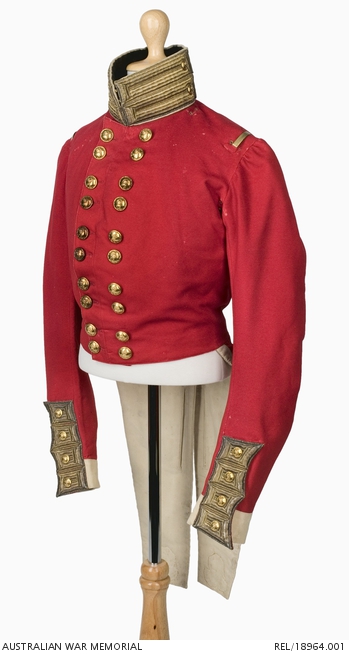| Place | Oceania: Australia |
|---|---|
| Accession Number | REL/18964.001 |
| Collection type | Heraldry |
| Object type | Uniform |
| Physical description | Bullion thread, Gilded brass, Gold bullion lace, Leather, Linen, Silk, Superfine wool, Wool twill |
| Maker |
Unknown |
| Place made | United Kingdom |
| Date made | c 1842-1848 |
| Conflict |
British Army Era, 1788-1870 |
Officer's full dress coatee : British 99th Regiment of Foot




Officer's full dress scarlet superfine double breasted coatee with cream superfine Prussian collar, edged with two pairs of buttoned gold lace loops. The centre front opening is un-laced and has five pairs of gilt buttons on each side. The cuffs are cream superfine and each cuff slash is trimmed with four square buttoned gold lace loops giving the appearance of a flap. The cuffs are secured to the sleeve with two brass hooks and embroidered eyes. Tails of coatee are edged and lined with white wool twill and have welt pockets inside each tail. Tail pockets were no longer made after 1848. The pockets and sleeves are lined with polished white linen. The outside of each tail has four square buttoned gold lace loops. At the bottom of each tail is a raised gold bullion embroidered rose with a short stem and leaves. At the back waist seam are two buttons. The body of the coatee is lined with heavily quilted and padded fawn silk twill and the waist is reinforced with red morocco leather except in the centre back section where there is a band of coarse scarlet velvet. This band was probably added at a later date but prior to acquisition. There is a fob pocket in the bodice lining on the wearer's left side. All buttons, made by Jennins & Co, London, are convex closed gilt buttons and bear a Queen Victoria crown and the number '99' . The coatee is missing epaulettes but the slides to hold them and embroidered eyelets are present on each shoulder.
Officer 99th Regiment of Foot. This regiment was first raised in 1760 and was disbanded several times before being raised in 1824 as the 99th (Lanarkshire) Regiment of Foot. The 99th came to Australia in 1843 and contingents served in Hobart, Sydney, Norfolk Island, New Zealand and Victoria at various times. The commanding officer was Lieutenant Colonel Henry Despard. The regiment left Australia in 1856. Coatees were replaced with tunics in 1855. Although the buttons on this coatee appear original and are not later additions, confirming it as belonging to an officer of the 99th Regiment, the facing colour on the collar and cuffs appears cream. Regulations specified pale yellow. The embroidered rose on the coat tails does not appear to be a standard tail decoration and may have been added at a later date.